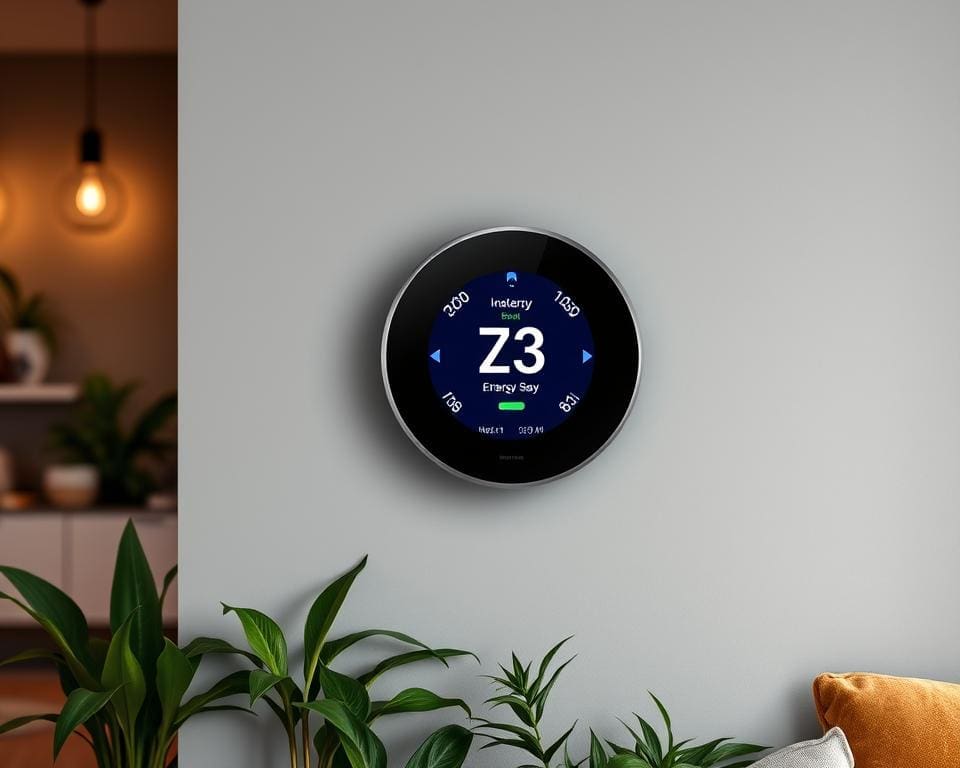In an era where sustainability and efficiency are paramount, the integration of a smart thermostat with energy-saving schedules stands as a beacon of innovation. This revolutionary device is designed to enhance your smart heating system with schedule optimization, allowing for more precise control over your home’s heating and cooling needs. By leveraging advanced technology, a smart thermostat can significantly improve energy usage efficiency while contributing to considerable reductions in energy bills.
This article explores the transformative capabilities of smart thermostats and how they adapt to your personal habits and preferences. By doing so, they offer a tailored experience that not only bolsters comfort but also aligns with the UK’s ambitious energy-saving goals. With the prospect of cutting down carbon emissions, integrating these intelligent devices into your home is not merely a choice but a vital step towards sustainable living, as detailed in this insightful energy-saving resource.
What is a Smart Thermostat?
A smart thermostat is a sophisticated device designed to optimise your home’s heating and cooling systems. Users can enjoy enhanced control and convenience with the ability to manage temperature settings remotely, making it an essential addition for those who value energy-efficient heating control. The smart thermostat definition lies in its capacity to automate climate schedules and provide valuable insights through smartphone applications.
Definition and Features
At its core, a smart thermostat offers key features that distinguish it from traditional models. These devices typically include:
- WiFi connectivity for remote access
- Learning algorithms that adjust settings based on user behaviour
- Integration with other smart home systems
- Real-time energy usage monitoring
Through a programmable thermostat for energy savings, users can tailor their heating schedules to align with their daily routines. This level of customisation not only improves comfort but also contributes to lower energy bills.
How It Differs from Traditional Thermostats
Understanding the difference between smart and traditional thermostats is crucial for homeowners looking to enhance their energy efficiency. Unlike traditional models, which require manual adjustments and lack remote control, smart thermostats alleviate the need for continuous input. They allow for:
- Advanced scheduling options that adapt over time
- Remote access through mobile apps
- Data tracking to monitor energy consumption
This evolution represents a significant leap in energy-efficient heating control, turning a once time-consuming task into a seamless experience. For more insights into energy-efficient solutions like air conditioning, consider exploring options available for your home to ensure comfort and savings.

Benefits of Using a Smart Thermostat with Energy-Saving Schedules
In today’s world, a smart thermostat with energy-saving schedules offers multiple advantages that extend beyond mere convenience. This technology not only provides significant energy savings but also enhances overall home comfort. Understanding these benefits can empower homeowners to make informed decisions about their heating solutions.
Cost Savings on Energy Bills
One of the primary advantages of a smart thermostat lies in its ability to generate cost-effective heating solutions. By intelligently regulating heating schedules according to user habits, these devices can minimise energy wastage. Many users report up to 30% reduction in energy costs annually, translating to substantial savings over time. Those seeking energy savings can appreciate the clear financial advantages of integrating a smart heating system.
Enhanced Home Comfort
A smart thermostat contributes to improved home comfort by consistently maintaining temperatures suited to the occupants’ preferences. The system adapts to lifestyle changes, ensuring warmth during chilly winter evenings and a cooler atmosphere on warm summer days. Features like geofencing allow the thermostat to adjust based on the occupants’ proximity, adding an extra layer of convenience. With a smart heating system, families can experience the optimal balance of comfort and functionality.
Smart Thermostat with Energy-Saving Schedules: Key Features
In today’s energy-conscious world, smart thermostats stand out for their innovative functionalities. Among these features, programmable and adaptive scheduling serve as critical elements that enhance energy efficiency and user convenience. These capabilities ensure that homes remain comfortable without excessive energy waste, making them an essential addition to modern living.
Programmable and Adaptive Scheduling
Programmable thermostat features empower users to set heating schedules tailored to their lifestyles. This customisation allows for optimal heating during peak usage times while reducing energy consumption when residents are away. Adaptive scheduling technology takes this a step further by learning user behaviour, automatically adjusting settings based on routine changes. Such intelligence accommodates busy families and professionals, ensuring the system operates effectively throughout the changing week.
Real-Time Energy Monitoring
Real-time energy monitoring brings an added layer of insight into household energy consumption. Through advanced energy monitoring systems, users can gain immediate feedback on their heating and cooling practices. By tracking energy usage effectively, households can identify inefficiencies and make informed adjustments to their habits. These insights contribute positively to both financial savings and environmental sustainability, solidifying the smart thermostat’s role in responsible energy management.
Smart thermostats combine functionality with innovative technology, making everyday living not only easier but also more sustainable. For those seeking a more efficient kitchen environment and overall lifestyle, exploring the essential household appliances can further enhance productivity and health in the home. Visit this link for more information on selecting the right appliances for a modern kitchen.
How to Set Up Energy-Saving Schedules
Setting up energy-saving schedules is an essential step in managing home heating efficiency. With a smart thermostat, the process involves straightforward steps, allowing you to enjoy the benefits quickly. Follow this guide to seamlessly integrate energy-saving features into your daily routine.
Step-by-Step Installation Guide
When installing a smart thermostat, begin by ensuring the power is turned off to avoid any accidents. Remove the existing thermostat carefully, following the manufacturer’s guidelines. As you install the new device, connect it to the existing wiring, ensuring everything is secure. After the physical installation, download the relevant application compatible with your thermostat. Connect the device to your WiFi, and proceed with the app’s setup instructions, which will typically include setting energy-saving schedules tailored to your lifestyle.
Tips for Optimising Your Schedule
Effective schedule optimisation for energy savings involves adjusting the thermostat settings based on when your home is occupied or not. Consider these heating schedule tips:
- Lower the temperature during overnight hours or when the home is unoccupied.
- Utilise geofencing features that automatically adjust the heating based on your location.
- Review and update your energy-saving schedules regularly to reflect any changes in your routine.
By following these strategies, you can significantly enhance energy efficiency while enjoying a comfortable living environment.
Integration with Your Smart Home
The trend of smart home integration is revolutionising how we manage our living spaces. With the right setup, smart thermostats can seamlessly connect with compatible devices such as lights, cameras, and voice assistants, making it easier to maintain an efficient home environment.
Compatibility with Other Smart Devices
Modern smart thermostats are designed for broad compatibility across a range of smart devices. This ensures that homeowners can create a cohesive environment where technology works in harmony. Popular devices include:
- Smart lights that adjust automatically based on temperature settings
- Security systems that interact with heating schedules for better energy management
- Voice-activated assistants like Amazon Alexa and Google Assistant, providing seamless control
Benefits of a Unified Smart Heating System
A unified smart home heating system delivers numerous advantages of integration. The ability to manage multiple devices from a single interface simplifies daily routines. Benefits include:
- Simplified management of heating and lighting, allowing homeowners to programme their environment effortlessly.
- Improved energy efficiency by harmonising schedules, reducing energy waste when rooms are unoccupied.
- Enhanced home comfort through tailored settings that adapt to personal preferences and timing.
Comparing Programmable Thermostats for Energy Savings
Choosing the right programmable thermostat can significantly impact energy consumption and savings in your home. With various models available, each offers different features that cater to specific preferences. Considering the best programmable thermostats on the market allows homeowners to weigh their options and make informed decisions.
Top Models and Their Features
Several top energy-saving models stand out for their innovative technology and user-friendly features:
- Nest Learning Thermostat: This model learns your schedule over time, adjusting automatically for optimal energy savings.
- Honeywell Home T9: Known for its multi-room control and compatibility with various smart devices, it ensures comfort throughout your space.
- Ecobee SmartThermostat: Featuring a voice assistant and room sensors, it provides personalised temperature control, enhancing user convenience.
Energy Efficiency Ratings
When evaluating energy-saving products, paying attention to thermostat energy efficiency ratings is crucial. These ratings, typically issued by energy regulatory bodies, indicate how effectively a thermostat uses energy. Higher efficiency ratings suggest that a product can significantly reduce energy consumption, making it a wise investment for environmentally-conscious consumers.
Final Thoughts on Energy-Conscious Thermostat Programming
In an era that champions sustainability, energy-conscious thermostat programming has emerged as a vital component of modern living. By integrating a smart thermostat equipped with energy-saving schedules, individuals can take proactive steps towards minimising their environmental impact while benefitting financially. The significance of adopting such technology cannot be overstated, as it not only helps reduce energy consumption but also aligns with a broader commitment to eco-friendly practices.
The adaptability and intelligence of smart thermostats provide formidable advantages. They learn and adjust based on user behaviour, ensuring optimal comfort without excessive energy expenditure. This synergy between smart technology and user-friendly programming maximises the smart thermostat benefits, enhancing overall home efficiency and comfort. Every degree matters; thus, the importance of meticulous programming is key in translating intent into tangible outcomes.
Ultimately, embracing energy-conscious thermostat programming is more than just a practical choice; it represents a conscious decision to contribute to a sustainable future. By thoughtfully utilising smart thermostat features, homeowners join a collective effort towards achieving energy efficiency, reaffirming that small changes at home can indeed lead to a greener environment. As we progress, investing in these solutions not only uplifts daily living but also plants the seeds for a more sustainable tomorrow.









